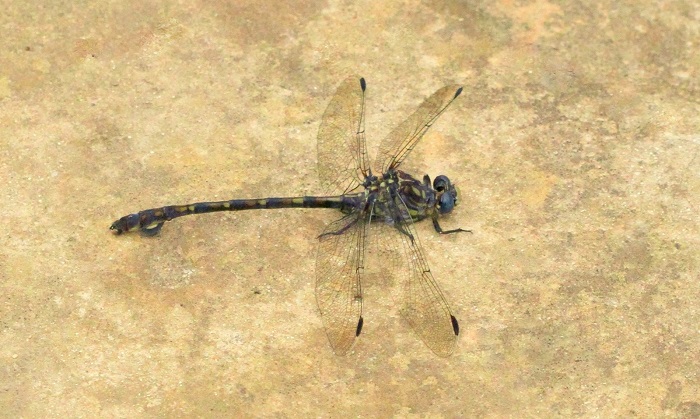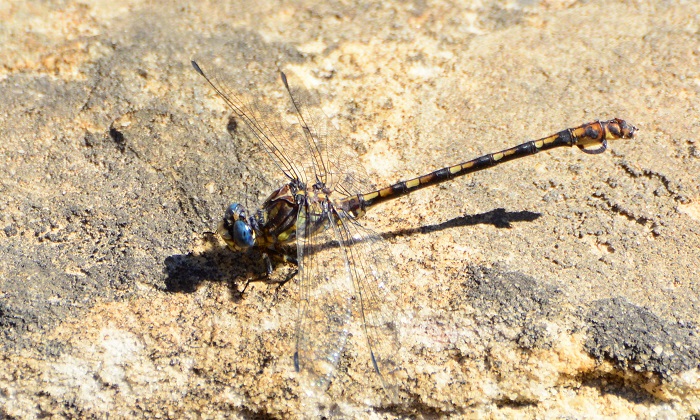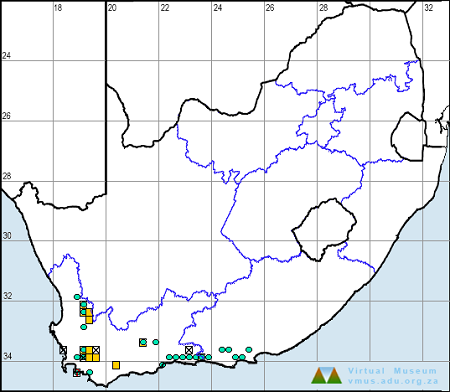Cover photo by Jean Hirons.
Find the Cape Thorntail in the FBIS database (Freshwater Biodiversity Information System) here.
Family Gomphidae
Identification

Bloukrans Pass, Eastern Cape
Photo by Desire Darling
Medium-large size
Length attains 63mm; Wingspan reaches 72mm.
The overall colouration of the Cape Thorntail is yellow and black with some brown shading. In mature males, the black markings develop a dark greyish-blue pruinosity. Males have large foliations on the underside of the 8th tail segment. Females resemble the males but are duller and have reduced tail foliations. Females are also more robust and have broader abdomens.

Seweweekspoort, Western Cape
Photo by Ryan Tippett
The Cape Thorntail most closely resembles the Common Thorntail (Ceratogomphus pictus), but is noticeably larger and darker. The abdomen segments are predominantly yellow in C. pictus, and mainly black in C. triceraticus. Additionally, the forwards projecting ‘thorn’ near the tip of the abdomen is broader and darker in the Cape Thorntail. The foliations on the abdomen also have thick black outer edges whereas Ceratogomphus pictus has thin black edging on the foliations.
Click here for more details on identification of the Cape Thorntail.
Habitat
The Cape Thorntail frequents shallow, fast-flowing streams and rivers. It prefers rocky habitats, often with large boulders, and is usually found in fairly open and hilly countryside. The Cape Thorntail occurs on rivers up to 800m above sea level.

Photo by Corné Rautenbach
Behaviour
The Cape Thorntail mostly perches on the ground or on rocks and boulders, but sometimes also sits on low twigs and bushes. They are usually found at the river but the odd individual may sometimes be encountered away from water. Most hunting is done from a perch atop a rock but they occasionally also forage by flying to and fro along a chosen route. The Cape Thorntail is usually a shy and weary species that can be difficult to approach.
The Cape Thorntail is on the wing from mid-October through to mid-April (see Phenology below).
Status and Conservation
Ceratogomphus triceraticus is an uncommon and very localised species. It is listed as Near Threatened in the IUCN Red List of Threatened Species. This grading is due to its relatively small, restricted distribution and the fact that it is reliant upon undisturbed habitats.

Vanrhynsdorp Waterfall, Western Cape
Photo by Ryan Tippett
Distribution
The Cape Thorntail is endemic to South Africa, where it is mostly restricted to the Western Cape province. It extends marginally into the Eastern Cape, reaching its eastern limit near Gqeberha (Port Elizabeth).
Below is a map showing the distribution of records for Cape Thorntail in the OdonataMAP database as at February 2020.

Below is a map showing the distribution of records for Cape Thorntail in the OdonataMAP database as at December 2024.

The next map below is an imputed map, produced by an interpolation algorithm, which attempts to generate a full distribution map from the partial information in the map above. This map will be improved by the submission of records to the OdonataMAP section of the Virtual Museum.


Ultimately, we will produce a series of maps for all the odonata species in the region. The current algorithm is a new algorithm. The objective is mainly to produce “smoothed” maps that could go into a field guide for odonata. This basic version of the algorithm (as mapped above) does not make use of “explanatory variables” (e.g. altitude, terrain roughness, presence of freshwater — we will be producing maps that take these variables into account soon). Currently, it only makes use of the OdonataMAP records for the species being mapped, as well as all the other records of all other species. The basic maps are “optimistic” and will generally show ranges to be larger than what they probably are.
These maps use the data in the OdonataMAP section of the Virtual Museum, and also the database assembled by the previous JRS funded project, which was led by Professor Michael Samways and Dr KD Dijkstra.
Phenology


Further Resources
The use of photographs by Corné Rautenbach, Desire Darling, and Jean Hirons is acknowledged.
Cape Thorntail Ceratogomphus triceraticus (Balinsky, 1963)
Other Common Names: Kaapse Doringstert (Afrikaans)
Recommended citation format: Loftie-Eaton M; Navarro R; Tippett RM; Underhill L. 2025. Cape Thorntail Ceratogomphus triceraticus. Biodiversity and Development Institute. Available online at https://thebdi.org/2020/05/27/cape-thorntail-ceratogomphus-triceraticus/
References: Tarboton, M; Tarboton, W. (2019). A Guide to the Dragonflies & Damselflies of South Africa. Struik Nature.
Samways, MJ. (2008). Dragonflies and Damselflies of South Africa. Pensoft
Samways, MJ. (2016). Manual of Freshwater Assessment for South Africa: Dragonfly Biotic Index. Suricata 2. South African National Biodiversity Institute, Pretoria

